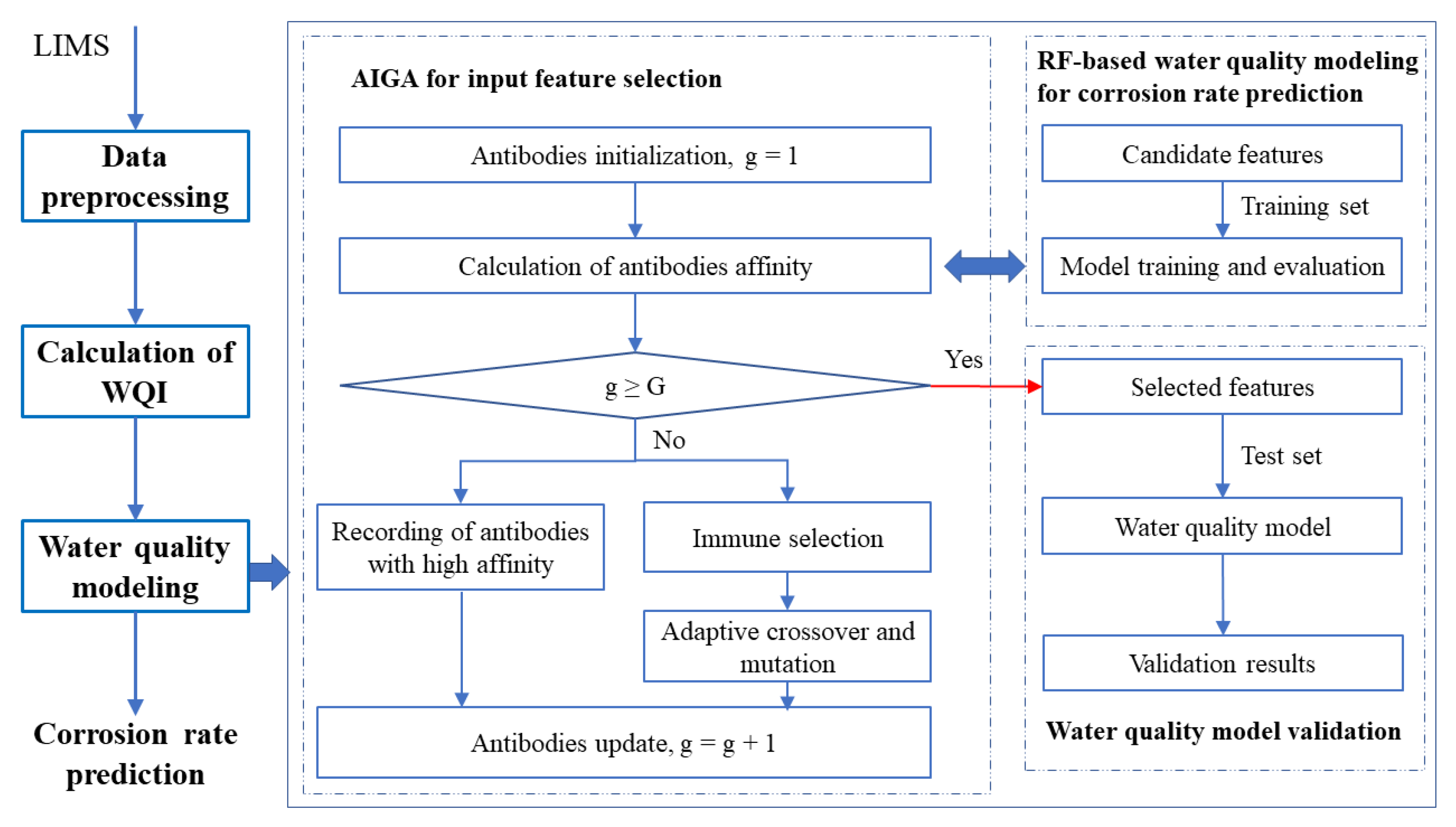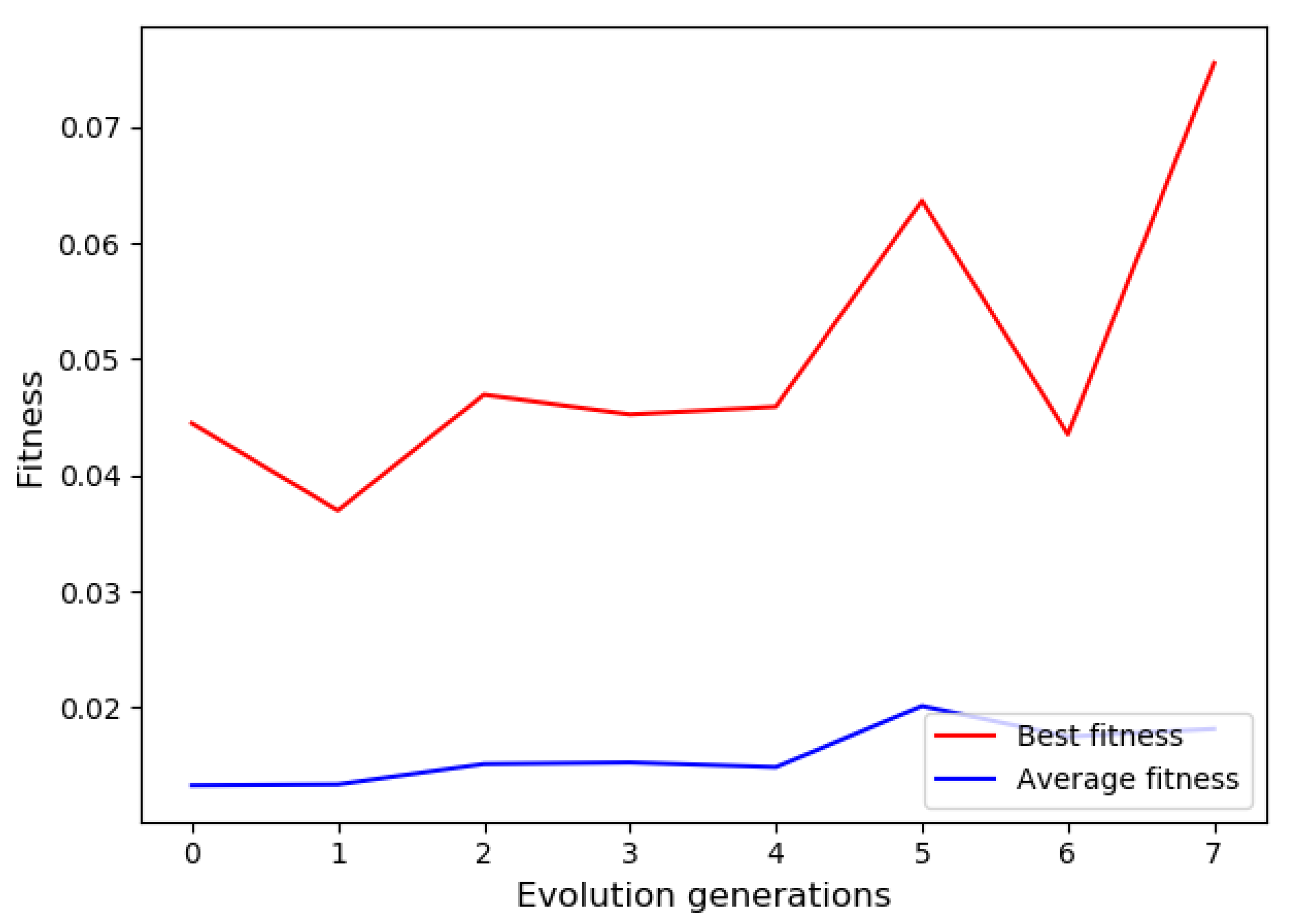Development of an Adaptive Model for the Rate of Steel Corrosion in a Recirculating Water System
Abstract
:1. Introduction
2. AIGA-RF Water Quality Model Based on WQIs
2.1. Data Preprocessing and WQI Calculation
2.1.1. Data Preprocessing
2.1.2. WQI Calculation
2.2. Corrosion Rate Prediction Using the AIGA-RF Method
2.2.1. Initialization of Antibodies
2.2.2. Antigen Recognition and Affinity Calculation
2.2.3. Evaluation of Termination Conditions
2.2.4. Identification of Effective Antibodies
2.2.5. Validation of the Obtained Corrosion Rate Prediction Model
3. Case Study of the AIGA-RF Water Quality Model
3.1. Feature Selection Using the Optimal Fitted Model and Validation of the Prediction Results
3.2. Comparison with Other Modeling Methods
4. Conclusions
Author Contributions
Funding
Institutional Review Board Statement
Informed Consent Statement
Data Availability Statement
Conflicts of Interest
References
- Chen, Z.B.; Zhang, H.; Liao, M.X. Integration Multi-Model to Evaluate the Impact of Surface Water Quality on City Sustainability: A Case from Maanshan City in China. Processes 2019, 7, 25. [Google Scholar] [CrossRef] [Green Version]
- Roberge, P.R.; Sastri, V.S. On-Line Corrosion Monitoring with Electrochemical Impedance Spectroscopy. Corrosion 1994, 50, 744–754. [Google Scholar] [CrossRef]
- Hahn, H.H.; Schreiner, H. Water-Quality Modeling. Prog. Water Technol. 1978, 10, 185–201. [Google Scholar]
- Peng, H.; Wang, Y.; Zhang, W.; Li, Y.; Wu, K.B.; Zhu, Q. A Coupled Water Quality-Quantity Model for Water Resource Allocation. In Proceedings of the 2009 3rd International Conference on Bioinformatics and Biomedical Engineering, Beijing, China, 11–13 June 2009; pp. 1–5. [Google Scholar]
- Shu, S.; Liu, S.; Zhang, D. Water Quality Model Calibration of Water Distribution Network Using Parallel fmGA Algorithm. In Proceedings of the 2010 International Conference on Electrical and Control Engineering, Wuhan, China, 25–27 June 2010; pp. 5801–5804. [Google Scholar]
- Phelps, E.B.; Streeter, H.W. A Study of the Pollution and Natural Purification of the Ohio River; United States Public Health Service: Washington, DC, USA, 1958. [Google Scholar]
- Yang, Y.; Wang, Y.; Zhang, W. Numerical Study of Coupled One-Dimensional and Two-Dimensional Hydrodynamic and Water Quality Model for Complex Lake and River Network Areas. In Proceedings of the 2012 International Symposium on Geomatics for Integrated Water Resource Management, Lanzhou, China, 19–21 October 2012; pp. 1–5. [Google Scholar]
- Pozdnyakov, D.V.; Lyaskovsky, A.V.; Tanis, F.J.; Lyzenga, D.R. Modeling of apparent hydro-optical properties and retrievals of water quality in the Great Lakes for SeaWiFS: A comparison with in situ measurements. In Proceedings of the IEEE 1999 International Geoscience and Remote Sensing Symposium. IGARSS’99 (Cat. No.99CH36293), Hamburg, Germany, 28 June–2 July 1999; Volume 5, pp. 2742–2744. [Google Scholar]
- Moustafa, K.A.F.; Gaafar, M.Y.; Abuelyazid, T. Modeling and Identification of A Stochastic Water-Quality System Using Actual Data. IEEE Proc. D Control Theory Appl. 1986, 133, 159–164. [Google Scholar] [CrossRef]
- Powers, W.F.; Canale, R.P. Some Applications of Optimization Techniques to Water-Quality Modeling and Control. IEEE Trans. Syst. Man Cybern. 1975, SMC5, 312–321. [Google Scholar] [CrossRef]
- Kaji, A.; Taheriyoun, M.; Taebi, A.; Nazari-Sharabian, M. Comparison and optimization of the performance of natural-based non-conventional coagulants in a water treatment plant. J. Water Supply Res. Technol. Aqua 2020, 69, 28–38. [Google Scholar] [CrossRef]
- Alizadeh, M.J.; Kavianpour, M.R. Development of wavelet-ANN models to predict water quality parameters in Hilo Bay, Pacific Ocean. Mar. Pollut. Bull. 2015, 98, 171–178. [Google Scholar] [CrossRef]
- D’Souza, C.D.; Kumar, M.S.M. Comparison of ANN models for predicting water quality in distribution systems. J. Am. Water Work. Assoc. 2010, 102, 92–106. [Google Scholar] [CrossRef]
- Zhu, C.; Zhao, X.; Zhou, J. ANN based on PSO for Surface Water Quality Evaluation Model and Its Application. In Proceedings of the 2009 Chinese Control and Decision Conference, Guilin, China, 17–19 June 2009; pp. 3264–3268. [Google Scholar]
- Gao, Q.; Ma, T.; Li, J.; Li, C. The research of the water quality prediction model for the circulating cooling water system. Appl. Mech. Mater. 2013, 385, 408–411. [Google Scholar] [CrossRef]
- Li, J.; Wang, T.; Zhao, Y.; Yang, J.; Gao, Q. Intelligent Analysis Platform of Industrial Circulating Water Based on VB and Matlab. In Proceedings of the 2015 IEEE International Conference on Mechatronics and Automation (ICMA), Beijing, China, 2–5 August 2015; pp. 654–658. [Google Scholar]
- Wang, T.; Li, J.; Liu, M.; Gao, Q.; Yang, J. Design and Implementation of Intelligent Decision-Making System Software for Industrial Circulating Cooling Water. In Proceedings of the 2016 IEEE International Conference on Mechatronics and Automation, Harbin, China, 7–10 August 2016; pp. 73–77. [Google Scholar]
- Yang, S.; Liu, X.; Cao, S.; Zhao, B.; Hu, Y.; Liu, F.; Men, H.; Xu, Z. Forecasting Corrosion Rate of Cooling Water Based on Least Squares Support Vector Machine. In Proceedings of the 2010 Fourth International Conference on Genetic and Evolutionary Computing, Shenzhen, China, 13–15 December 2010; pp. 833–836. [Google Scholar]
- Yang, Z.; Junfang, L.; Qiang, G. The Predication of the Adhesion Rate Based on NARX Model. Appl. Mech. Mater. 2014, 687, 1346–1349. [Google Scholar]
- Radwan, M. Evaluation of Different Water Quality Parameters for the Nile River and the Different Drains. In Proceedings of the 9th International Water Technology Conference, Sharm El-Sheikh, Egypt, 17–20 March 2005; Available online: http://citeseerx.ist.psu.edu/viewdoc/summary?doi=10.1.1.302.1775 (accessed on 10 August 2021).
- Chandrashekar, G.; Sahin, F. A survey on feature selection methods. Comput. Electr. Eng. 2014, 40, 16–28. [Google Scholar] [CrossRef]
- Somerscales, E.F.C. Two-Phase Flow Heat Exchangers: Thermal-Hydraulic Fundamentals and Design; Kakaç, S., Bergles, A.E., Fernandes, E.O., Eds.; Springer: Dordrecht, The Netherlands, 1988; pp. 407–460. [Google Scholar]
- Zhang, R.; Nie, F.; Li, X.; Wei, X. Feature selection with multi-view data: A survey. Inf. Fusion 2019, 50, 158–167. [Google Scholar] [CrossRef]
- Lee, C.Y.; Wen, M.S. Establish Induction Motor Fault Diagnosis System Based on Feature Selection Approaches with MRA. Processes 2020, 8, 1055. [Google Scholar] [CrossRef]
- Tran, H.K.; Son, H.H.; Duc, P.V.; Trang, T.T.; Nguyen, H.N. Improved Genetic Algorithm Tuning Controller Design for Autonomous Hovercraft. Processes 2020, 8, 66. [Google Scholar] [CrossRef] [Green Version]
- Licheng, J.; Lei, W. A novel genetic algorithm based on immunity. IEEE Trans. Syst. Man Cybern. Part A Syst. Hum. 2000, 30, 552–561. [Google Scholar] [CrossRef] [Green Version]
- Li, Z.; Gu, J.; Zhuang, H.; Kang, L.; Zhao, X.; Guo, Q. Adaptive molecular docking method based on information entropy genetic algorithm. Appl. Soft Comput. 2015, 26, 299–302. [Google Scholar] [CrossRef]
- Yang, S.; Yang, M.; Wang, S.; Huang, K. Adaptive immune genetic algorithm for weapon system portfolio optimization in military big data environment. Clust. Comput. 2016, 19, 1359–1372. [Google Scholar] [CrossRef]
- Que, Y.; Zhong, W.; Chen, H.; Chen, X.; Ji, X. Improved adaptive immune genetic algorithm for optimal QoS-aware service composition selection in cloud manufacturing. Int. J. Adv. Manuf. Technol. 2018, 96, 4455–4465. [Google Scholar] [CrossRef]
- Breiman, L. Statistical Modeling: The Two Cultures (with comments and a rejoinder by the author). Stat. Sci. 2001, 16, 199–231. [Google Scholar] [CrossRef]
- Wu, X.; Gao, Y.C.; Jiao, D. Multi-Label Classification Based on Random Forest Algorithm for Non-Intrusive Load Monitoring System. Processes 2019, 7, 337. [Google Scholar] [CrossRef] [Green Version]
- Zhu, J.; Ge, Z.; Song, Z.; Gao, F. Review and big data perspectives on robust data mining approaches for industrial process modeling with outliers and missing data. Annu. Rev. Control 2018, 46, 107–133. [Google Scholar] [CrossRef]
- Debels, P.; Figueroa, R.; Urrutia, R.; Barra, R.; Niell, X. Evaluation of Water Quality in the Chillán River (Central Chile) Using Physicochemical Parameters and a Modified Water Quality Index. Environ. Monit. Assess. 2005, 110, 301–322. [Google Scholar] [CrossRef] [PubMed]
- Štambuk-Giljanović, N. Water quality evaluation by index in Dalmatia. Water Res. 1999, 33, 3423–3440. [Google Scholar] [CrossRef]
- Stambuk-Giljanović, N. Comparison of Dalmatian water evaluation indices. Water Env. Res. 2003, 75, 388–405. [Google Scholar] [CrossRef]
- Miller, W.W.; Joung, H.M.; Mahannah, C.N.; Garrett, J.R. Identification of Water Quality Differences in Nevada Through Index Application. J. Environ. Qual. 1986, 15, 265–272. [Google Scholar] [CrossRef]
- Al Obaidy, A.H.; Maulood, B.; Kadhem, A. Evaluating Raw and Treated Water Quality of Tigris River within Baghdad by Index Analysis. J. Water Resour. Prot. 2010, 2, 629–635. [Google Scholar] [CrossRef] [Green Version]
- Mukate, S.; Wagh, V.; Panaskar, D.; Jacobs, J.A.; Sawant, A. Development of new integrated water quality index (IWQI) model to evaluate the drinking suitability of water. Ecol. Indic. 2019, 101, 348–354. [Google Scholar] [CrossRef]
- Ewaid, S.H.; Abed, S.A.; Kadhum, S.A. Predicting the Tigris River water quality within Baghdad, Iraq by using water quality index and regression analysis. Environ. Technol. Innov. 2018, 11, 390–398. [Google Scholar] [CrossRef]
- Liu, X.; Yang, Z.; Pan, W. An Improved Adaptive Immune Genetic Algorithm Based on Information Entropy. In Proceedings of the 2015 International Conference on Industrial Informatics-Computing Technology, Intelligent Technology, Industrial Information Integration, Wuhan, China, 3–4 December 2015; pp. 6–9. [Google Scholar]
- Squillero, G.; Tonda, A. Divergence of character and premature convergence: A survey of methodologies for promoting diversity in evolutionary optimization. Inf. Sci. 2016, 329, 782–799. [Google Scholar] [CrossRef] [Green Version]



| Parameter | Design Upper and Lower Limits | Permissible Upper and Lower Limits | Unit | Frequency |
|---|---|---|---|---|
| pH | 8.4–8.5 | 8.1–8.6 | / | 3 times/day |
| Turbidity | <20 | <35 | mg/L | 3 times/day |
| Residual chlorine | 0.5–0.8 | 0.2–1 | mg/L | 3 times/day |
| Potassium ion | <30 | <40 | mg/L | 1 time/day |
| Calcium hard | 400–500 | <800 | mg/L | 1 time/day |
| Concentration multiple | 4–5 | 3–6 | / | 1 time/day |
| Total hardness | 600–800 | 400–1200 | mg/L | 1 time/day |
| Conductivity | 1000–2000 | 400–3000 | mg/L | 1 time/day |
| Total iron | 0.5–0.8 | <1 | mg/L | 1 time/day |
| Chloride ion | 300–400 | <500 | mg/L | 3 times/week |
| Heterotrophic bacteria | <5000 | <10,000 | Counts | 1 time/week |
| Suspended matter | 10–20 | <30 | mg/L | 1 time/week |
| # | Model Parameter | Value |
|---|---|---|
| 1 | Antibody population size | 60 |
| 2 | Memory capacity | 6 |
| 3 | Number of parameters (variables) | 12 |
| 4 | Diversity evaluation parameter | 0.95 |
| 5 | Number of decision trees in RF | 10 |
| 6 | Maximum number of iterations | 8 |
| Model | Number of Features | MSE | MAPE |
|---|---|---|---|
| AIGA-RF | 4 | 0.000127 | 0.31997 |
| AIGA-BP | 5 | 0.000222 | 0.41478 |
| AIGA-SVR | 5 | 0.000154 | 0.79707 |
| IGA-RF | 8 | 0.000195 | 0.32173 |
| GA-RF | 5 | 0.000207 | 0.57074 |
| PCA-RF | 8 | 0.000467 | 0.81747 |
| RF | 12 | 0.000405 | 0.65352 |
Publisher’s Note: MDPI stays neutral with regard to jurisdictional claims in published maps and institutional affiliations. |
© 2021 by the authors. Licensee MDPI, Basel, Switzerland. This article is an open access article distributed under the terms and conditions of the Creative Commons Attribution (CC BY) license (https://creativecommons.org/licenses/by/4.0/).
Share and Cite
Huang, X.; Gao, Y.; Zhu, L.; He, G. Development of an Adaptive Model for the Rate of Steel Corrosion in a Recirculating Water System. Processes 2021, 9, 1639. https://doi.org/10.3390/pr9091639
Huang X, Gao Y, Zhu L, He G. Development of an Adaptive Model for the Rate of Steel Corrosion in a Recirculating Water System. Processes. 2021; 9(9):1639. https://doi.org/10.3390/pr9091639
Chicago/Turabian StyleHuang, Xiaochuan, Yan Gao, Ling Zhu, and Ge He. 2021. "Development of an Adaptive Model for the Rate of Steel Corrosion in a Recirculating Water System" Processes 9, no. 9: 1639. https://doi.org/10.3390/pr9091639
APA StyleHuang, X., Gao, Y., Zhu, L., & He, G. (2021). Development of an Adaptive Model for the Rate of Steel Corrosion in a Recirculating Water System. Processes, 9(9), 1639. https://doi.org/10.3390/pr9091639






